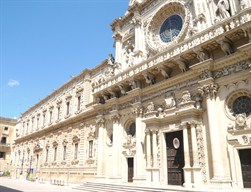Lecce
 According to legend, even before the Trojan War, there was a city founded by Messapians and placed at the entrance of another town, Rupiae, birthplace of the poet, playwright and writer Ennius. What is certain is that the Romans conquered in the third century BC a city inhabited by the people of the Iapygians and latinized the name in Lupiae. It enjoyed a period of great splendour in the Imperial Age (especially during the reign of Marcus Aurelius), when the nucleus of the city was moved a few miles to the north-east, taking the name of Licea or Litium, and was directly connected to the Hadrian Port. The city was evangelized by the patrician Publius Orontius, the first bishop and martyr, and its future patron saint. Sacked by the Ostrogoth king Totila in 542 and in 549, Lecce came under the control of various peoples and rulers. The Normans elevated it to a county (Tancredi, the last king of the dynasty, was born in Lecce) and then they were followed by the Swabians, Angevins and Aragonese. Resurging as a commercial hub and cultural center in the fifteenth century, Lecce became part, along with the whole of southern Italy, of the Spanish monarchy. The new walls, the castle (built to protect the city from attacks by pirates and Turks) and the current Porta Napoli date back to the reign of Charles V. In the seventeenth century, a busy period of construction and urban renewal, especially coinciding with the episcopate of Luigi Pappacoda (1639-1670), gave to Lecce the Baroque appearance that still distinguishes it (in the photo: the Basilica of Santa Croce and the Palazzo dei Celestini).
According to legend, even before the Trojan War, there was a city founded by Messapians and placed at the entrance of another town, Rupiae, birthplace of the poet, playwright and writer Ennius. What is certain is that the Romans conquered in the third century BC a city inhabited by the people of the Iapygians and latinized the name in Lupiae. It enjoyed a period of great splendour in the Imperial Age (especially during the reign of Marcus Aurelius), when the nucleus of the city was moved a few miles to the north-east, taking the name of Licea or Litium, and was directly connected to the Hadrian Port. The city was evangelized by the patrician Publius Orontius, the first bishop and martyr, and its future patron saint. Sacked by the Ostrogoth king Totila in 542 and in 549, Lecce came under the control of various peoples and rulers. The Normans elevated it to a county (Tancredi, the last king of the dynasty, was born in Lecce) and then they were followed by the Swabians, Angevins and Aragonese. Resurging as a commercial hub and cultural center in the fifteenth century, Lecce became part, along with the whole of southern Italy, of the Spanish monarchy. The new walls, the castle (built to protect the city from attacks by pirates and Turks) and the current Porta Napoli date back to the reign of Charles V. In the seventeenth century, a busy period of construction and urban renewal, especially coinciding with the episcopate of Luigi Pappacoda (1639-1670), gave to Lecce the Baroque appearance that still distinguishes it (in the photo: the Basilica of Santa Croce and the Palazzo dei Celestini).
